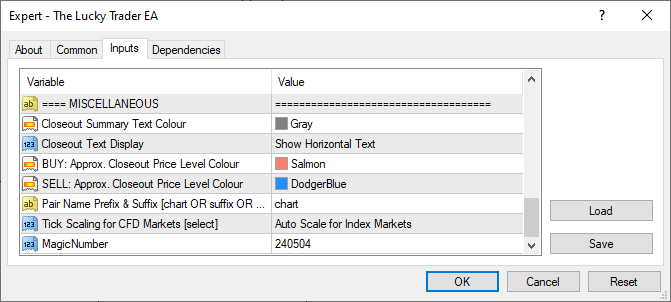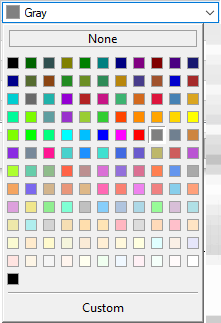MISCELLANEOUS

Closeout Summary Text Colour
The colour of the text in the chart describing the summary of the closure, e.g. upon Initial: Hidden TP or pruning events.

Closeout Text Display
The presentation of the closure summary in the chart area.

| Closeout Text Display | Description |
|---|---|
| No Text Displayed | No details of the closeout gets displayed in the chart area. |
| Show Horizontal Text | The details of the closeout gets displayed in a horizontal line in the chart area. |
| Show Vertical Text | The details of the closeout gets displayed in a vertical line in the chart area. |
BUY:Approx. Closeout Price Level Colour
The colour of the line in the chart area giving an approximate estimate where the exit to take place for open sell trades. The exit level is determined by one of the Initial: Take Profit, Initial: Hidden TP, Closure: Target Closure $ Amount or Closure: Target Profit Pips Closure.

SELL:Approx. Closeout Price Level Colour
The colour of the line in the chart area giving an approximate estimate where the exit to take place for open buy trades. The exit level is determined by one of the Initial: Take Profit, Initial: Hidden TP, Closure: Target Closure $ Amount or Closure: Target Profit Pips Closure.

Pair Name Prefix & Suffix
There are standard market names which are commonly used for currency pairs, like EURUSD, GBPUSD, USDCHF, USDJPY etc. Many broker offers these standard market names on their MT5 platform, however some brokers may add some prefix or suffix to the market names resulting in broker specific symbols like EURUSDecn, EURUSD.r or mEURUSD etc.
As a convenience, the EA makes an attempt to discover the broker specific prefix and suffix and use those automatically. Alternatively, the prefix and the suffix can be manually configured as well. The below table shows the different approaches how to configure the prefix and suffix parts of the market symbols for trading.
| Approach | Input Entered into Pair Name Prefix & Suffix | Trading Outcome Examples |
|---|---|---|
| The chart's symbol is used to automatically discover the prefix & suffix | chart | When the EA is attached to the EURUSD chart then it trades the EURUSD GBPUSD USDCHF etc symbols with no prefix or suffix. |
| When the EA is attached to the EURUSD.r chart then it trades the EURUSD.r GBPUSD.r USDCHF.r etc symbols with the .r suffix. | ||
| When the EA is attached to the mEURUSD.r chart then it trades the mEURUSD.r mGBPUSD.r mUSDCHF.r etc symbols with the m prefix and .r suffix. | ||
| Manual entry of suffix only | .r | The EA always trades the EURUSD.r GBPUSD.r USDCHF.r etc symbols with the .r suffix. |
| Manual entry of prefix & suffix | m .r | The EA always trades the mEURUSD.r mGBPUSD.r mUSDCHF.r etc symbols with the m prefix and .r suffix. |
If the prefix and suffix should be added to other non-FOREX symbol names as well (like US30) then add the word always to the end of the Pair Name Prefix & Suffix.
Tick Scaling for CFD Markets
Provides a consistent tick, pip, cent and point values across various markets and brokers. This is specific to stock indices, metal, commodity etc markets keeping the cent or dollar unit consistently applied. Wherever the EA is configured with a 'Pip' value then it is consistently mapped to the cent or dollar unit for those non-FOREX markets.

| Tick Scaling for CFD Markets | Description |
|---|---|
| Auto Scale for Index Markets | Based on the characteristics of the market the EA automatically recognizes if the underlying market was a stock index market, like the US30, GER30 or JP225 etc. In this case the 'pip' values configured for the EA are scaled up to the 'dollar' value of the index: 12345.67 |
| Never Scale | The EA does not scale up the 'pip' values even if the market could be recognized as a stock index market. |
| Always Scale | The EA applies the scaling up of the 'pip' values to the 'dollar' value even if the market could not be recognized as stock index market. This option is useful if the 'dollar' based approach is desired for trading. |
Examples:
| Trading Approach | Chart of Market | Stop Loss EA Parameter Value | Tick Scaling for CFD Markets Value | Buy Entry Fill Price | Calculated Stop Loss Value | Description |
|---|---|---|---|---|---|---|
| Index market with $1.00 unit | US30 | 100 | Auto Scale for Index Markets Alternative: Always Scale |
26123.90 | 26023.90 | The EA scales the 100 'pips' parameter to market price of 100.00 US dollar units (i.e. 100.00 points) |
| FOREX pair with 0.0001 unit | EURUSD | 100 | Auto Scale for Index Markets Alternative: Never Scale |
1.13412 | 1.12412 | The EA keeps the 100 'pips' parameter as it is |
| Gold market with $0.01 unit | XAUUSD | 100 | Auto Scale for Index Markets Alternative: Never Scale |
1288.23 | 1287.23 | The EA maps the 100 'pips' parameter to 100 cent units |
| Gold market with $1.00 unit | XAUUSD | 100 | Always Scale | 1288.23 | 1188.23 | The EA maps the 100 'pips' parameter to 100 dollar units |
| Oil market with $0.01 unit | USOil | 100 | Auto Scale for Index Markets Alternative: Never Scale |
56.752 | 55.752 | The EA maps the 100 'pips' parameter to 100 cent units |
| Oil market with $1.00 unit | USOil | 10 | Always Scale | 56.752 | 46.752 | The EA maps the 10 'pips' parameter to 10 dollar units |
| Copper market with $0.01 unit | COPPER | 100 | Auto Scale for Index Markets Alternative: Never Scale |
2.9245 | 1.9245 | The EA maps the 100 'pips' parameter to 100 cent units |
| Cocoa market with $0.01 unit | COCOA | 100 | Auto Scale for Index Markets Alternative: Never Scale |
2160 | 2060 | The EA maps the 100 'pips' parameter to 100 cent units |
| Natural gas market with $0.01 unit | NGAS | 100 | Auto Scale for Index Markets Alternative: Never Scale |
2.843 | 1.843 | The EA maps the 100 'pips' parameter to 100 cent units |
Magic Number
The EA marks its orders with this value when submitting to the broker account, and picks up orders which are marked with this magic number value and belong to the chart of the EA. In the case of multiple EA's running on the same market ensure that they get unique Magic Number allocations to avoid cross-impact between the EA instances handling the orders. See Configuration and Operation Principles section for more explanation and setup examples.